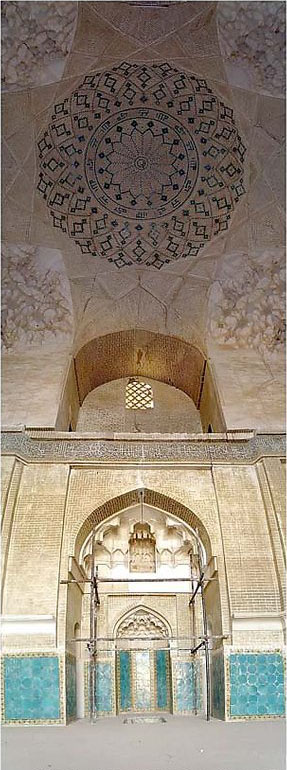Top Qs
Timeline
Chat
Perspective
Malek Mosque
Mosque in Kerman, Iran From Wikipedia, the free encyclopedia
Remove ads
The Malek Mosque (Persian: مسجد ملک کرمان, romanized: Masjid-e Malik; Arabic: مسجد ملك), also called the Imam Mosque (transl. Masjid-i imam), is a mosque is located in Kerman, Iran. The mosque was built at the time of Turan Shah I, Kerman Seljuk Sultanate, between 1077 and 1096 CE, and is the biggest and oldest mosque in Kerman.[1][2]
The mosque was added to the Iran National Heritage List on 7 October 1967, administered by the Cultural Heritage, Handicrafts and Tourism Organization of Iran.
Remove ads
Architecture
Summarize
Perspective
The building has four portals. The dome at the front of the structure, the iwan behind it, and the minaret in the northeast corner are attributed to the Seljuk period. The building has been restored many time since its construction in the early part of the 11th century.[3]
There is a large sahn in the middle of the complex, containing a small pool. There are slight differences to each iwan: the iwan in the west is not as deep as others, while others are wider. Each iwan are covered by ogee vaults, surrounded by between one and four naves, including the mihrab side. The façade and interior design of the iwan in front of the mihrab significantly differs from the other iwans.[3]
The dome sits on the mihrab wall and three arches placed between two rows of rectangular pillars created by two square pillars. These are connected to each other by two small arches on the sides. Some depth was given to the mihrab by creating a corridor in front of the mihrab wall, where the mihrab wall is located. Although the building's dome in front of the mihrab is small, it is interesting in terms of its height. Transition elements in the corners of the dome are pendentive arches. The faces of the arches of the arcades and portals are decorated with glazed bricks, added at a later period.[3]
Terracotta and stucco decorations were found during 20th-century repairs, that comprise curved branches and compositions consisting of Kufic inscription bands.[3]
Remove ads
Gallery
- The sahn
- The sahn and small pool
- The main iwan and sahn at twilight
- Squat minaret of the mosque
- Kufic inscription
- The interior of the mihrab wall
- The main Shabestan interior
- The interior of the dome
- The interior of the dome under different lighting conditions
- The interior of the dome under different lighting conditions
See also
References
Further reading
External links
Wikiwand - on
Seamless Wikipedia browsing. On steroids.
Remove ads











